If you’re one of the people who hate and fear all snakes, this might be a moment to remind yourself that this one is merely an image in the computer, as well as a small, slender, agile reptile that is harmless to us humans.
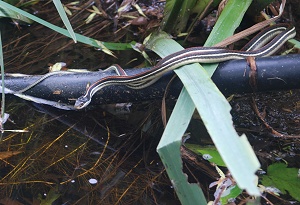 My husband spotted this Red-lined Ribbon Snake, Thamnopsis proximus rubrilineatus, basking on the water return pipe of the water garden, near the stand of water iris at the head of the lily pool. The first time I saw one, I was nine, and my mother and I were resting near a low-water crossing. A beautiful little snake, graceful and harmless…it became my favorite snake that day. (It’s now my favorite small, slender, aquatic snake…other snakes have found their place in my list of favorites.)
My husband spotted this Red-lined Ribbon Snake, Thamnopsis proximus rubrilineatus, basking on the water return pipe of the water garden, near the stand of water iris at the head of the lily pool. The first time I saw one, I was nine, and my mother and I were resting near a low-water crossing. A beautiful little snake, graceful and harmless…it became my favorite snake that day. (It’s now my favorite small, slender, aquatic snake…other snakes have found their place in my list of favorites.)
T.p. rubrilineatus is a shy creature, and in all the years I’ve tried, this is the first time one has held still long enough to get several mostly-good pictures. Snakes aren’t easy to photograph in whole because of their shape–you can almost never get the whole snake in one picture, all of it in focus. This particular species, being shy, usually takes to the water and swims into cover before you can do more than grab a single (in my case often blurry) shot. So I crept forward very slowly, easing out the zoom telephoto, while the snake eyed me warily. It was a partly cloudy day, and the snake was (as it prefers to be) in the shade of vegetation as well…so exposures were long enough to be affected by unsteady hands, and most were blurry. It wasn’t quite dark enough to trigger the flash, except once
I enlarged the head, to show the beautiful patterns of color and scales:
I find I can see more from photographing critters and then enlarging the images in the computer than I can with aging eyesight alone: that little pale crescent in front of the eye, and that white spot on top of the head…never noticed that before. Incidentally, the pipe the snake rests on is less than two inches in diameter (probably about 1.75 inches.)
After I inched closer, and the sun broke through, the snake decided it had had enough of that giant eye coming nearer (these snakes are preyed on by herons, among other things. A big staring eye means you’ve been seen…and there might be a beak somewhere. Or a paw with claws and a mouth with teeth. Bullfrogs take the smaller specimens of this species.) It began to move down the pipe toward the water, but much more slowly than usual…so I got more images:
And a closer look at the lateral head:
So, unless you’re a tadpole, a very small fish, or a very small frog…you have nothing to worry about if you see this little snake (or its relatives) near a small creek (favorite spot, in the streamside vegetation or clear shallow water.) Stop a moment (or several) and watch it–but if you startle it, it may flash into the water and out of sight faster than you can focus your camera or binoculars.
We have seventeen identified species of snakes on the place–I don’t see them all every year, but the reappearance of T. p. rubrilineatus in the water garden in late spring/early summer is always a pleasure.
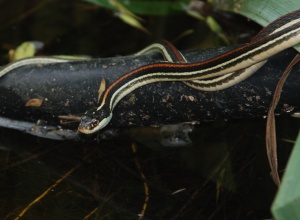
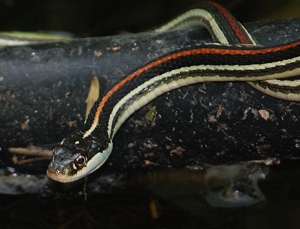
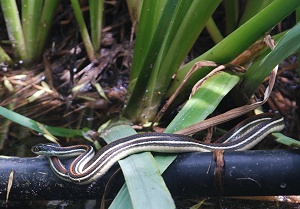
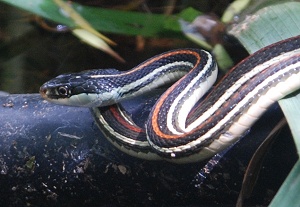
Comment by mimbles — May 20, 2010 @ 11:13 pm
Gorgeous! I love the colours in its stripes. Here in Sydney Australia we don’t run to pretty little harmless snakes but I’ve managed to grow up liking them all anyway!
Comment by Mary Anne in Kentucky — May 21, 2010 @ 5:01 am
Aging eyesight, pah! When I was eleven or twelve, I bent down to pick up a nice stick that was lying on the driveway, and was quite startled when it stuck its tongue out at me. From the vantage of the top of the garbage can, I could see it was a black snake and nothing poisonous. I had new glasses, too.
Comment by cdozo — May 21, 2010 @ 5:34 am
Those are amazing pictures of a beautiful snake. Well done!
Comment by Jim Hetley — May 21, 2010 @ 5:39 am
Beautiful photos, lovely snake.
Comment by Adrianne — May 21, 2010 @ 6:57 am
What a lovely snake! It’s much prettier than my first snake of the season – a western garter that was very nearly the same color as the concrete he was sunning on. I need to get in the habit of carrying a camera with me.
Comment by elizabeth — May 21, 2010 @ 7:55 am
Every time I go outside without camera & binoculars, I see something I would have IDed or recorded if I’d had them along. So my rule (broken often enough to remember WHY it’s a rule) is that if I go out, I take them. Naturally, if my arms are full of laundry basket, this doesn’t happen, but otherwise…I do try.
Comment by elizabeth — May 21, 2010 @ 7:56 am
Thanks. And having had this luck, I probably won’t see another photographable snake all season.
Comment by elizabeth — May 21, 2010 @ 7:56 am
Sometimes the luck is with you.
Comment by elizabeth — May 21, 2010 @ 8:01 am
My mother’s rule about sticks was “They’re all snakes until you know for sure they’re not.” South Texas has many snakes, and many snakes that look *exactly* like a stick if they’re still. I didn’t believe her (not fully, anyway) until the day that I stepped over a “stick” and it then moved and slid over the foot I’d left behind. I froze there, teetering, and watching the little gray-brown-with-bark-markings snake go on its way. Luckily, not one of the venomous ones.
She knew a woman who was a serious snake fan–had lots of snakes, including rattlesnakes, and let them loose in the house part of the time. She claimed they wouldn’t bite her because she wasn’t afraid of them. I’m not like that. Snakes belong in the wild, and though I enjoy looking at some of them, that does not include rattlesnakes.
Comment by elizabeth — May 21, 2010 @ 8:14 am
I was scared of Australian snakes because I knew many of them were venomous, dangerously so, and I didn’t have a clue what the “bad” ones looked like, compared to any harmless snakes you might find. Here, I have a mental image of the startling but harmless, the pretty and harmless, the pretty and deadly (coral snake), and the large and deadly (here, mostly the western diamondback rattlesnake, a snake of very touchy disposition, but also including the copperhead and the water moccasin and a few other rattlesnakes. I know that any heap of rope or hose is likely to be a snake; anything that gleams in the grass or leaves or on a branch is something’s shiny scales. I know that on the first warm days of spring, the snakes come out to sun on the new grass–and I know that in midsummer, that inviting patch of shade under a juniper is likely to be the resting place of a rattlesnake, who will not want to share it.
But not there. So I wasn’t tempted to head out into the bush by myself, without someone along who could say “Not up there, you’re likely to step on a [snakename I’ve now forgotten.]”
But there…how big the dangerous ones were, what they looked like in their own habitat,
Comment by Mike J — July 5, 2010 @ 2:04 pm
A few weeks ago I came back from the grocery store & spotted a solid white snake in the middle of the back yard. I squatted by it & we examined each other for a couple minutes. It was beautiful.(I don’t know what it thought of me.) I think it was a common grass snake. Snow-white but had dark eyes.A neighbor saw it the next week, in his yard.